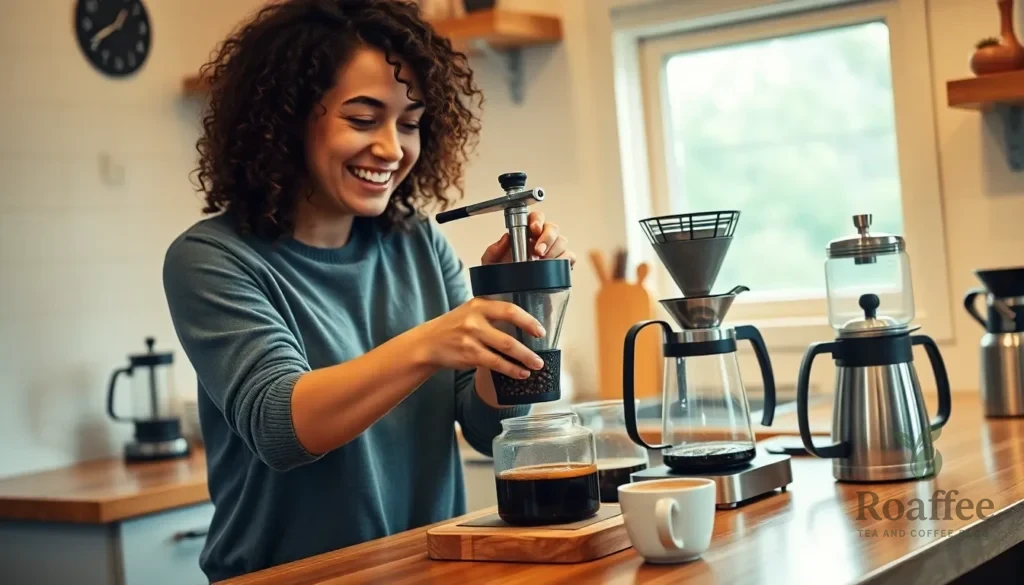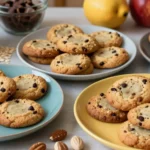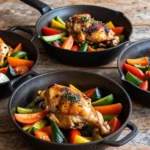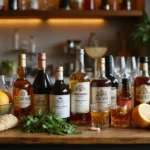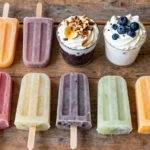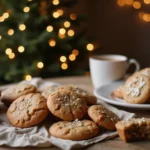We’ve all been there – standing in line at our favorite coffee shop, craving that perfect cup that costs more than our lunch. But what if we told you that the best coffee recipe isn’t found in expensive cafes, but right in your own kitchen? With just a few simple techniques and quality ingredients, you can transform your daily coffee routine into a barista-level experience.
The secret to exceptional home-brewed coffee lies in understanding the fundamentals: proper bean selection, precise measurements, and optimal brewing methods. We’ve tested countless combinations and brewing techniques to bring you a foolproof recipe that delivers rich, flavorful coffee every single time. Whether you’re a morning coffee enthusiast or someone who needs that afternoon pick-me-up, this recipe will revolutionize your home brewing game.
Skip the expensive coffee runs and lengthy wait times. Let’s jump into creating the perfect cup that’ll have you wondering why you ever left the house for coffee in the first place.
Equipment Needed
Creating exceptional coffee at home requires the right tools to unlock your beans’ full potential. We’ll guide you through the essential equipment that transforms ordinary brewing into extraordinary results.
Essential Coffee Brewing Equipment
Coffee Grinder
We recommend a burr grinder as your most important investment. Burr grinders crush beans evenly rather than chopping them like blade grinders. This consistency ensures uniform extraction and prevents bitter or sour notes from uneven particle sizes.
Digital Scale
Precision matters when brewing coffee at home. We use a digital scale to measure both coffee and water accurately. Most recipes call for a 1:15 to 1:17 coffee-to-water ratio by weight rather than volume measurements.
Brewing Device
Choose from several excellent options based on your preferences:
- French press for full-bodied coffee
- Pour-over dripper (V60 or Chemex) for clean bright flavors
- AeroPress for versatile brewing methods
- Drip coffee maker for convenience
Kettle
Water temperature affects extraction significantly. We suggest a gooseneck kettle for pour-over methods or any kettle that allows temperature control. Target water temperature should range between 195°F and 205°F.
Timer
Consistent brewing times produce consistent results. We time our brewing process to ensure proper extraction without over-brewing.
Optional Tools for Better Results
Water Thermometer
Temperature precision elevates your coffee quality. We monitor water temperature to hit that sweet spot between 195°F and 205°F for optimal extraction.
Coffee Storage Container
Airtight containers preserve bean freshness longer than original packaging. We store our beans in opaque containers away from light and heat sources.
Quality Water Filter
Water quality dramatically impacts coffee taste since it comprises 98% of your final cup. We filter our water to remove chlorine and other impurities that interfere with coffee flavors.
Coffee Cupping Spoons
Professional tasting spoons help evaluate your brewing results. We use these to taste and adjust our technique for consistent improvement.
Cleaning Supplies
Regular equipment maintenance ensures pure flavors. We clean our grinder and brewing equipment weekly with specialized coffee cleaning products to prevent oil buildup.
Ingredients
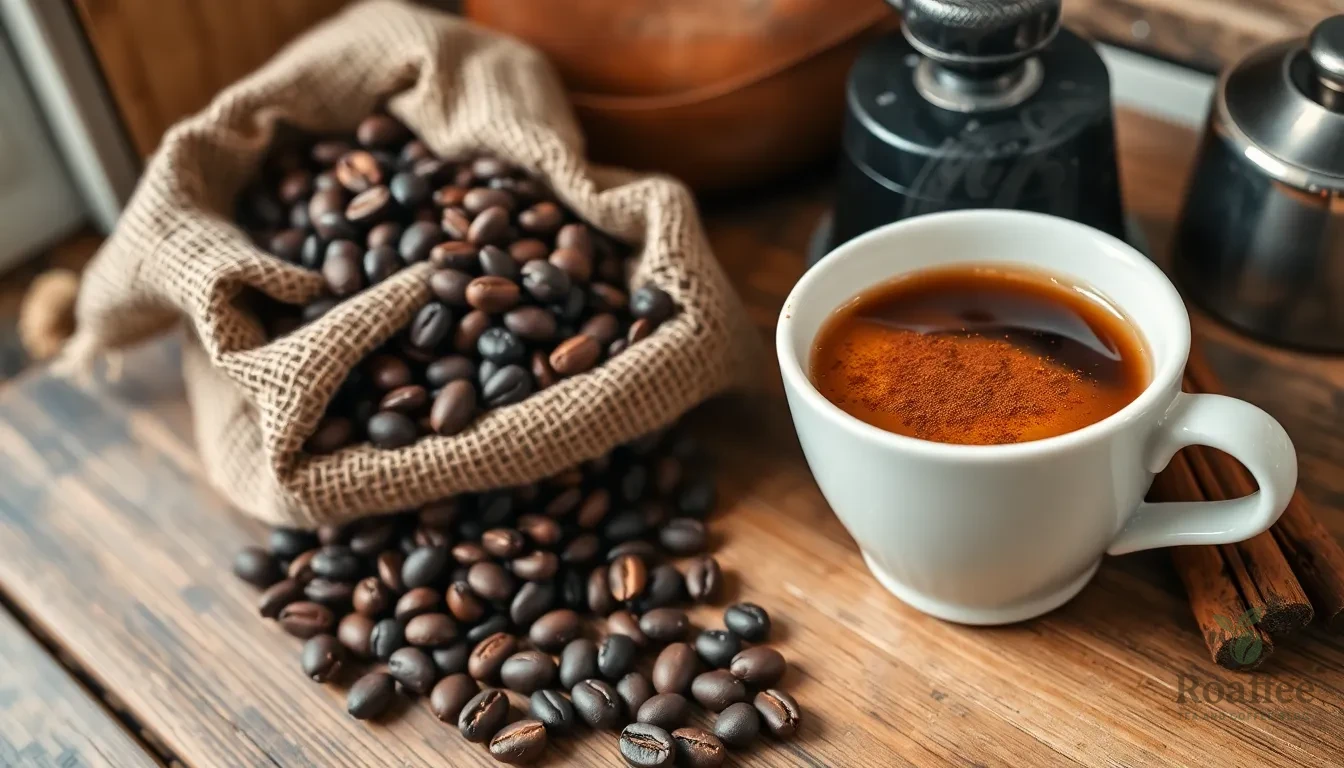
We’ve gathered the perfect combination of ingredients to create exceptional coffee that rivals your favorite café. Each component plays a crucial role in developing the rich flavors and aromatic qualities that make our homemade coffee recipe truly outstanding.
Coffee Beans Selection
- Freshly roasted whole coffee beans (2 tablespoons per 6 oz of water)
- Light roast beans for fruity and floral notes
- Medium roast beans for balanced flavor profiles
- Dark roast beans for bolder, richer taste experiences
Preparation Notes:
- Grind beans just before brewing to preserve aroma and taste
- Use a burr grinder for consistent grind size
- Store whole beans in airtight containers away from light and heat
Water Quality Requirements
- Filtered water (6-8 oz per serving)
- Water temperature between 195°F and 205°F (90°C to 96°C)
- Quality water filter (Brita or similar brand recommended)
Water Specifications:
| Temperature Range | Extraction Quality | Brewing Time |
|---|---|---|
| 195°F – 205°F | Optimal extraction | 4-6 minutes |
| Below 195°F | Under-extracted | Extended time needed |
| Above 205°F | Over-extracted/bitter | Reduced time required |
Additional Flavor Enhancers
- Ground cinnamon (1/4 teaspoon per cup)
- Cocoa powder (1/4 teaspoon per cup)
- Whole milk or cream (2-4 tablespoons per cup)
- Granulated sugar (1-2 teaspoons per cup, optional)
- Vanilla extract (1/8 teaspoon per cup)
- Nutmeg (pinch per cup)
- Cardamom pods (1-2 per cup)
- Heavy cream for frothing
- Brown sugar for deeper sweetness
Instructions
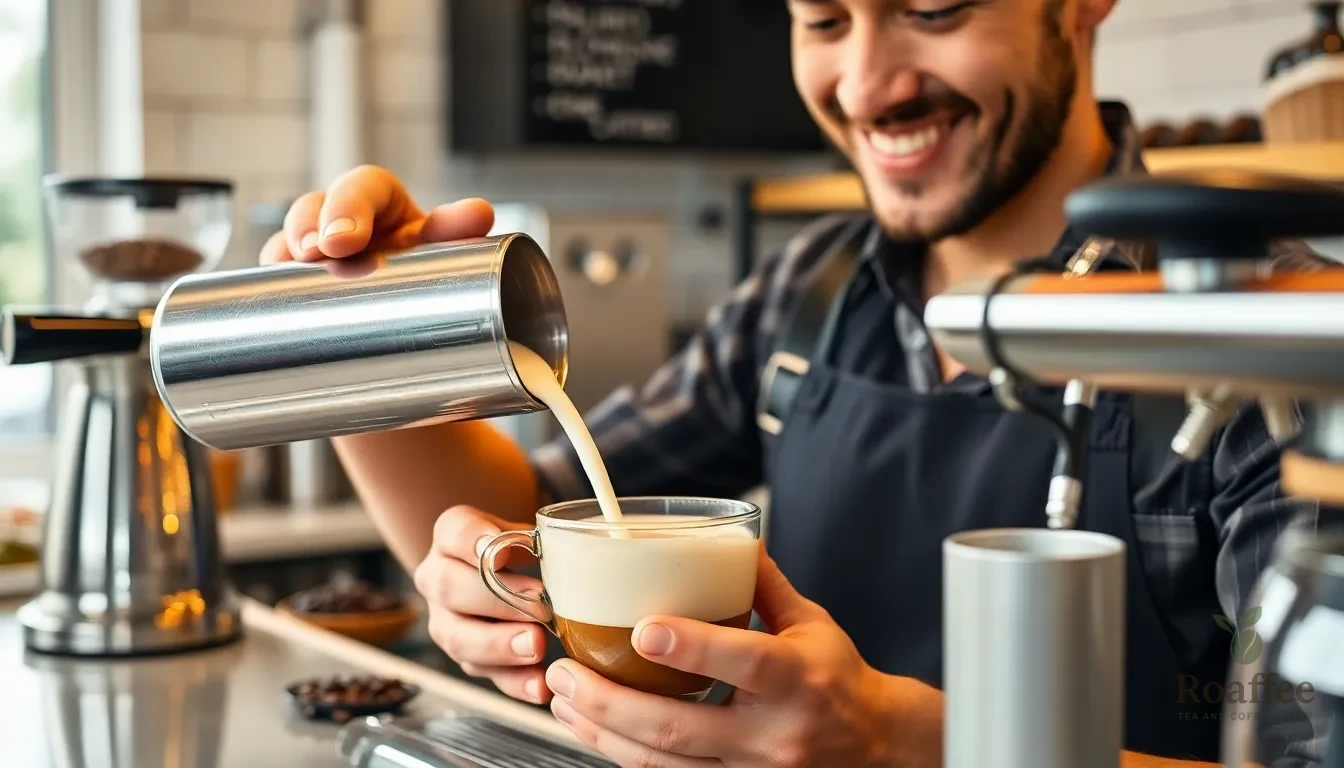
Now that we have our equipment ready and ingredients prepared, let’s walk through the step-by-step process for creating exceptional coffee at home. These techniques will help you achieve that perfect cafe-quality brew every time.
Prep
We begin by setting up our workspace and preparing our ingredients for optimal brewing results. Start by measuring out your coffee beans using a digital scale – we’ll need approximately 1 part coffee to 15-16 parts water for most brewing methods.
Grind your coffee beans to the appropriate coarseness for your chosen brewing method. Pour-over and drip coffee require a medium grind, while French press needs a coarse grind. The grinding should happen just before brewing to preserve the beans’ oils and aromatic compounds.
Heat your filtered water to the ideal temperature range of 195°F to 205°F. If you don’t have a thermometer, bring water to a boil and let it sit for 30 seconds. This temperature ensures proper extraction without burning the coffee grounds.
Pre-warm your brewing equipment by rinsing it with hot water. This step maintains consistent temperature throughout the brewing process and helps prevent heat loss. Empty the warming water before adding your coffee grounds.
Set up your timer and have all additional ingredients like milk, cream, or flavor enhancers within easy reach. Organization at this stage makes the brewing process smoother and more enjoyable.
Brewing Methods
Hot Beaten Coffee (Cafe-Style)
We start with this popular method that creates a frothy, creamy beverage similar to what you’d find in cafes. Combine 1.5 teaspoons instant coffee, 1.5 tablespoons sugar, and 3 tablespoons hot water in a cup.
Beat the mixture briskly for 3-4 minutes until it becomes frothy and light in color. The vigorous beating incorporates air, creating that signature foam texture. Meanwhile, boil 1 cup of milk in a separate pan.
Pour the hot milk into a glass jar and shake vigorously to create foam, or use a handheld frother for easier frothing. Add half of the foamy milk to your coffee mixture and stir gently. Top with the remaining milk and foam.
Sprinkle cinnamon or cocoa powder on top for additional flavor enhancement. This method produces a rich, creamy coffee that rivals expensive cafe beverages.
Cold Brew Coffee
For cold brew, we use a 4:1 ratio of filtered water to medium-coarse ground coffee beans. Combine 4 cups of water with 1 cup of coffee grounds in a large jar or cold brew maker.
Stir the mixture thoroughly to ensure all grounds are saturated. Cover and let steep at room temperature for 12-15 hours, or up to 24 hours for a stronger flavor profile.
Strain the mixture through a fine-mesh strainer or cheesecloth to remove all grounds. The resulting concentrate can be stored in the refrigerator for up to two weeks.
Serve the cold brew concentrate diluted with ice, water, or your choice of milk or cream. Start with a 1:1 ratio of concentrate to liquid and adjust to taste preference.
Simple Iced Coffee
Brew regular coffee using cold water and ground coffee in your preferred ratio. We recommend using a rich roast for more robust flavor that won’t get diluted by ice.
Allow the coffee to cool to room temperature, then refrigerate until chilled. This prevents the ice from melting too quickly when served.
Fill glasses with ice and pour the chilled coffee over it. Add a splash of half-and-half or milk for creaminess. Sweeten with condensed milk or your preferred sweetener to taste.
This method creates a refreshing coffee drink perfect for warm weather while maintaining the full coffee flavor profile.
Timing and Temperature
Precise timing ensures optimal extraction and prevents over-brewing, which can lead to bitter flavors. Most pour-over methods require 3-4 minutes of total brew time, while French press needs exactly 4 minutes of steeping.
Water temperature plays a crucial role in extraction quality. Too hot water (above 205°F) can scorch the coffee, while too cool water (below 195°F) results in under-extraction and weak flavor.
For beaten coffee, the 3-4 minute beating time is essential for achieving the proper frothy consistency. Rushing this step results in less foam and a denser texture.
Cold brew requires patience – the 12-24 hour steeping time allows for full flavor extraction without heat. Shorter steeping times produce weaker concentrate that lacks the smooth, rich taste cold brew is known for.
Monitor your brewing process closely and adjust timing based on your taste preferences. Keep notes on what works best for your exact equipment and coffee beans.
Finishing Touches
Once brewing is complete, serve your coffee immediately for the best temperature and flavor experience. Pre-warmed cups help maintain the coffee’s optimal serving temperature longer.
Add milk, cream, or plant-based alternatives gradually while stirring to achieve your desired consistency and color. Start with small amounts and build up to prevent overwhelming the coffee’s natural flavors.
Enhance your coffee with optional additions like ground cinnamon, cocoa powder, or vanilla extract. These additions should complement, not mask, the coffee’s inherent characteristics.
For iced variations, ensure your ice is made from filtered water to avoid introducing unwanted flavors. Large ice cubes melt slower and provide less dilution than smaller ones.
Taste and adjust sweetness levels as needed. Natural sweeteners like honey or maple syrup can add complexity, while traditional sugar provides clean sweetness without competing flavors.
Brewing Methods
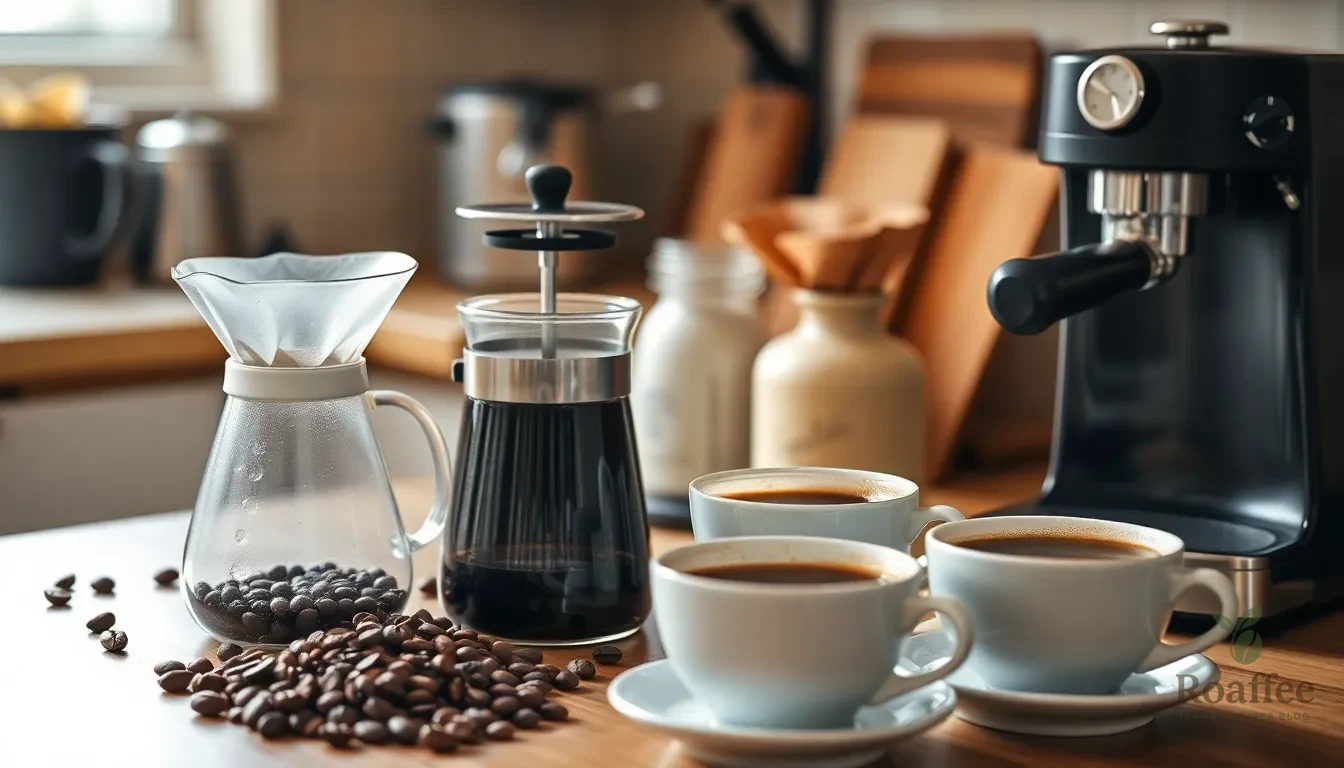
We’ve explored the essentials of great coffee making and now it’s time to master the actual brewing techniques. Each method offers unique characteristics that will transform your daily coffee experience.
Pour Over Method
We recommend the pour over method for coffee enthusiasts who want complete control over their brewing process. This technique involves manually pouring hot water over medium-fine coffee grounds placed in specialized drippers like the Chemex, Hario V60, or Kalita Wave.
Water temperature should stay between 195-205°F (90-96°C) for optimal extraction. Grind size varies depending on your dripper: fine grounds like table salt work best for smaller cones while medium-coarse grounds similar to kosher salt suit larger brewers like the Chemex.
The entire process takes approximately 3-4 minutes and produces a clean, sweet flavor with subtle notes that highlight your coffee’s unique characteristics. Pour over brewing excels at creating one or two cups with exceptional clarity and balance.
French Press Method
We favor the French press for its simplicity and ability to create robust, full-bodied coffee. This full-immersion method steeps coarse coffee grounds in hot water for 4-5 minutes before pressing the plunger down to separate the grounds from the brew.
Coarse grounds resembling sea salt prevent over-extraction and minimize sediment in your cup. The French press retains coffee oils and some sediment, which creates a richer flavor profile and heavier mouthfeel compared to filtered methods.
This brewing technique requires minimal equipment and delivers consistently strong coffee that satisfies those who prefer bold, intense flavors. The method works particularly well for making multiple servings at once.
Espresso Method
We turn to espresso when we want concentrated, intense coffee with maximum flavor impact. Espresso machines force hot water at high pressure through finely ground coffee, producing a concentrated shot topped with golden crema in just 20-30 seconds.
Finely ground coffee is essential for proper extraction during the short brewing time. The high-pressure extraction creates rich, complex flavors with a thick, syrupy texture that serves as the perfect base for lattes, cappuccinos, and other specialty drinks.
While espresso requires specialized equipment, the investment pays off for coffee lovers who want café-quality drinks at home. The method delivers unmatched intensity and serves as the foundation for countless coffee variations.
Cold Brew Method
We choose cold brew when we want smooth, mellow coffee with minimal acidity. This method steeps coarse coffee grounds in cold water for 12-24 hours, creating a concentrate that can be diluted with water or milk.
The extended steeping time allows for gentle extraction that produces a naturally sweet, less acidic coffee concentrate. Coarse grounds work best to prevent over-extraction during the long brewing process.
Cold brew requires advance planning due to the lengthy steeping time but rewards patience with refreshing, well-balanced coffee that’s perfect for iced drinks. The concentrate stays fresh in the refrigerator for up to two weeks, making it convenient for daily consumption.
| Method | Grind Size | Brew Time | Flavor Profile | Equipment Needed |
|---|---|---|---|---|
| Pour Over | Fine to Medium-Coarse | 3-4 minutes | Clean, sweet, nuanced | Dripper (V60, Chemex, Kalita) |
| French Press | Coarse | 4-5 minutes | Full-bodied, rich | French press device |
| Espresso | Fine | 20-30 seconds | Intense, concentrated | Espresso machine |
| Cold Brew | Coarse | 12-24 hours | Smooth, mellow, low acid | Jar or cold brew maker |
Timing and Temperature Guidelines
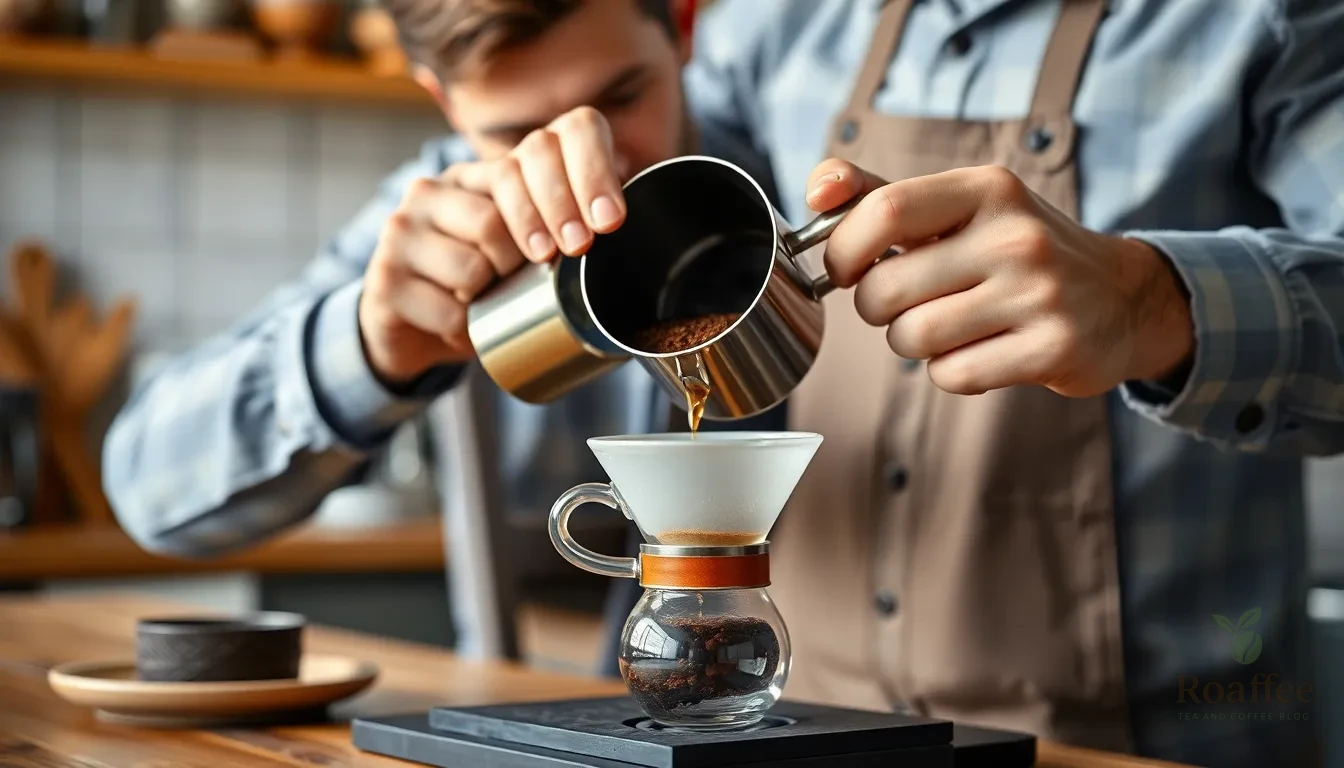
We believe mastering the timing and temperature aspects of coffee brewing transforms your home coffee experience from ordinary to extraordinary. Getting these fundamentals right ensures optimal flavor extraction without the bitter notes that plague many homemade cups.
Water Temperature Essentials
Water temperature plays a crucial role in extracting the perfect balance of flavors from your coffee grounds. We recommend heating your water to 195-205°F (90-96°C) for most brewing methods to achieve optimal extraction without introducing unwanted bitterness. This temperature range allows the water to dissolve the desirable compounds from your coffee beans while avoiding over-extraction of harsh elements.
When water exceeds 205°F, it can scorch the coffee grounds and create bitter flavors that overpower the natural sweetness and complexity of your beans. Conversely, water below 195°F fails to extract enough of the coffee’s essential oils and flavors, resulting in weak and underwhelming coffee.
Brewing Time by Method
Different brewing methods require exact timing to achieve their characteristic flavor profiles. We’ve found that adhering to these timeframes consistently produces exceptional results:
| Brewing Method | Optimal Time | Temperature Range |
|---|---|---|
| Pour-over | 2.5-3 minutes | 195-205°F |
| French press | 4-5 minutes steeping | 195-205°F |
| Drip coffee | ~5 minutes | 195-205°F |
| Cold brew | 12-24 hours | Cold water |
| Espresso | 25-30 seconds | 190-196°F |
| Moka pot | Until bubbling stops | Stovetop heat |
Pour-over methods require precise timing as the water flows through the coffee bed in a controlled manner. We monitor the entire extraction process, ensuring the total brew time falls between 2.5 to 3 minutes for optimal flavor development.
French press brewing involves a longer steeping time of 4 to 5 minutes, allowing the coffee grounds to remain in contact with water for full immersion extraction. This extended contact time creates the method’s signature full-bodied character.
Temperature Control Techniques
Maintaining consistent water temperature throughout the brewing process requires attention to detail. We recommend bringing water to a rolling boil, then letting it sit for 30 seconds to 1 minute to reach the ideal temperature range. This technique works especially well when you don’t have a thermometer available.
For those serious about precision, investing in a variable temperature kettle eliminates guesswork and ensures repeatable results. These kettles allow you to set exact temperatures and maintain them throughout the brewing process.
Timing Your Extraction
Proper timing begins the moment water contacts coffee grounds. We start our timers immediately when we begin pouring water over the coffee bed, whether using a pour-over dripper or preparing a French press. This consistency helps us replicate successful brews and troubleshoot any issues that arise.
Over-extraction occurs when brewing time exceeds the recommended ranges, leading to bitter and harsh flavors. Under-extraction happens when brewing time falls short, resulting in sour and weak coffee that lacks body and depth.
Directions for Perfect Extraction

Perfect extraction forms the foundation of exceptional coffee brewing at home. We achieve this by dissolving the optimal amount of flavorful compounds from coffee grounds into water.
Water Temperature Control
We maintain water temperature between 198°F and 202°F (92-94°C) for optimal extraction results. Water below this range under-extracts flavors and produces weak coffee. Higher temperatures risk burning the grounds and create bitter over-extraction.
Automatic brewers excel at maintaining consistent temperature ranges throughout the brewing process. Manual brewing methods require careful heating and constant monitoring to achieve these precise temperatures. We recommend using a reliable thermometer to track water temperature accurately.
Brewing Time for Each Method
Different brewing methods require exact timing to achieve balanced extraction. We follow these research-based guidelines for optimal results:
| Brewing Method | Brew Time | Grind Size | Notes |
|---|---|---|---|
| Pour-Over | 2.5-4 minutes | Fine (V60) / Medium-coarse (Chemex) | Control pour speed for extraction |
| French Press | 4-5 minutes | Coarse | Full immersion steeping |
| Espresso | 25-30 seconds | Very fine | High pressure extraction |
| Cold Brew | 12-24 hours | Coarse | Cold water steeping |
Pour-over brewing allows us to adjust extraction time by controlling our pour rate. French press methods use full immersion where grounds steep completely in water before pressing. Espresso requires precise timing under high pressure to produce concentrated shots. Cold brew demands extended steeping periods but rewards us with smooth low-acid coffee.
Pouring Technique
Proper pouring technique ensures uniform saturation and balanced extraction across all coffee grounds. We pour slowly and evenly in circular motions during pour-over brewing to achieve consistent results.
Gentle agitation during pouring enhances extraction by distributing water and coffee solubles evenly throughout the brew bed. We avoid concentrating water in single spots or pouring too quickly as this creates channeling and uneven extraction.
Steady controlled pours allow us to maintain optimal contact time between water and grounds. We focus on keeping our pouring motion consistent to prevent under-extracted areas that would compromise the final cup quality.
Flavor Variations
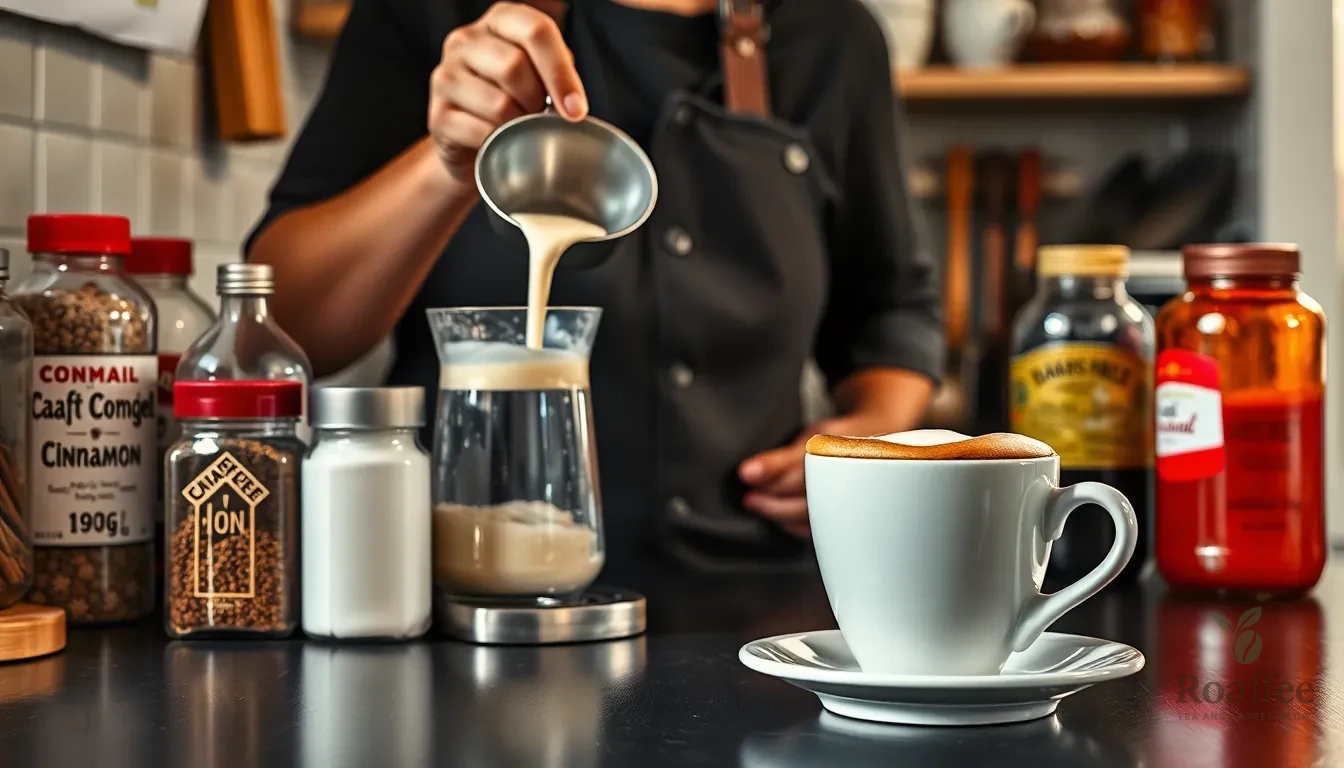
Once you’ve mastered the basic brewing techniques, we can explore countless ways to customize your coffee and create unique flavor profiles. These variations allow us to tailor each cup to match our personal preferences and mood.
Adding Milk and Cream
The type of milk or cream we choose dramatically transforms our coffee’s texture and taste. Whole milk provides the richest mouthfeel and creates beautiful microfoam when frothed, while skim milk offers a lighter option with fewer calories. Half-and-half strikes a perfect balance between richness and lightness, and heavy cream delivers an indulgent, velvety experience.
For those seeking dairy-free alternatives, we have many plant-based options that each bring unique characteristics to our coffee. Almond milk adds a subtle nutty flavor, while oat milk creates an exceptionally creamy texture that rivals traditional dairy. Soy milk offers a neutral taste and excellent frothing capabilities, and coconut milk introduces tropical notes with natural sweetness.
We recommend frothing milk by shaking it vigorously in a jar or using a handheld frother to enhance both texture and taste. This simple technique transforms ordinary milk into a cafe-quality foam that elevates our home brewing experience.
Sweetening Options
Traditional sugar remains a classic choice, but we can explore various sweetening methods to enhance our coffee’s flavor profile. Sweetened condensed milk adds richness along with sweetness, creating a luxurious texture that works particularly well in iced coffee preparations.
Flavored syrups open up endless possibilities for customization. Vanilla syrup provides warm, comforting notes, while caramel syrup adds buttery sweetness with complex undertones. Chocolate syrup transforms our coffee into a mocha-inspired treat, and homemade sweeteners allow us to control both flavor intensity and ingredients.
For those monitoring calorie intake, artificial sweeteners offer flexibility without compromising taste. We can adjust sweetness levels gradually to find our perfect balance, whether using liquid stevia, erythritol, or other sugar alternatives.
Spice Additions
Spices transform ordinary coffee into an aromatic and flavorful experience that engages all our senses. Ground cinnamon remains the most popular choice, adding warmth and complexity when sprinkled on top of hot coffee or mixed directly into the grounds before brewing.
Cocoa powder creates an instant mocha effect without added sugar, providing rich chocolate notes that complement coffee’s natural bitterness. Nutmeg introduces a warm, slightly sweet spice that pairs beautifully with milk-based coffee drinks.
We can experiment with other warming spices like cardamom, allspice, or even a pinch of cayenne pepper for those who enjoy a spicy kick. These additions allow us to customize our coffee to match seasonal preferences or create signature blends that reflect our individual taste preferences.
Make-Ahead Tips
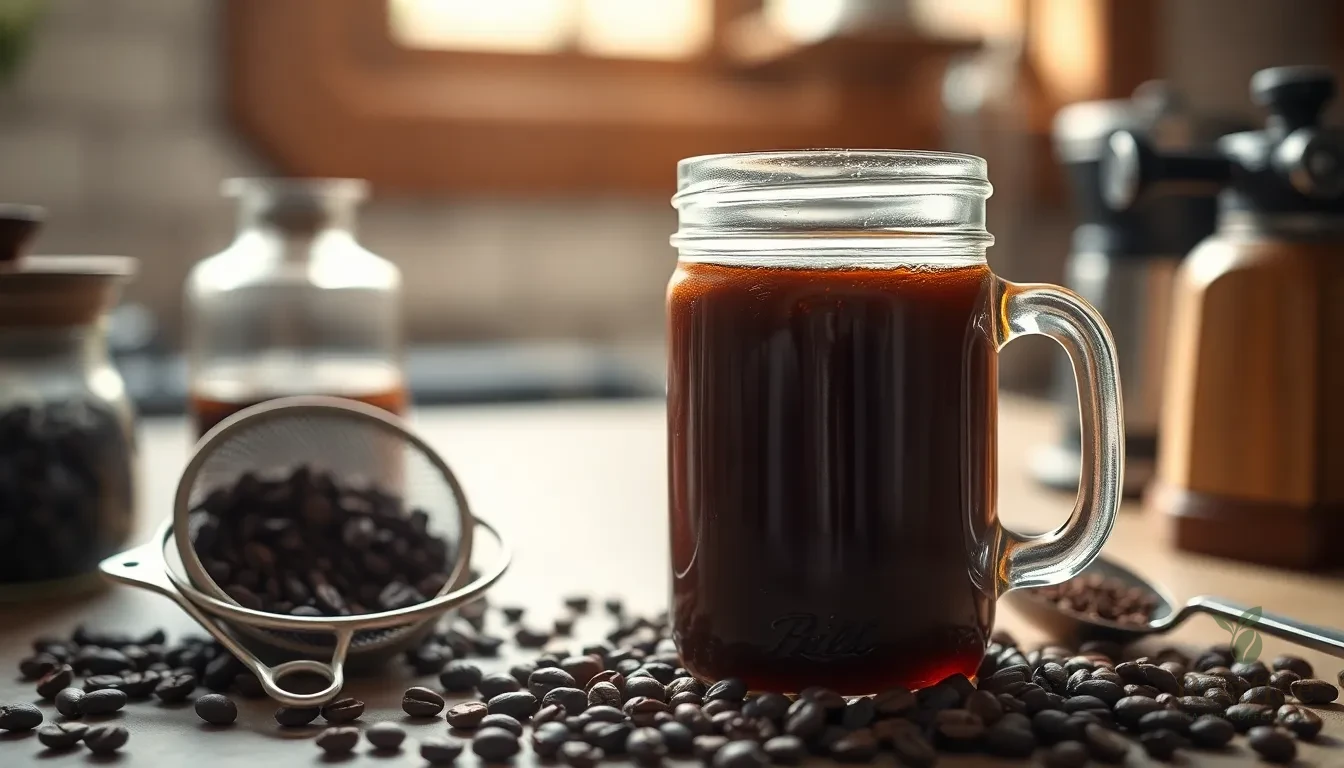
Planning your coffee preparation ahead of time transforms our daily routine into a seamless experience. Smart preparation strategies allow us to enjoy exceptional coffee without the morning rush.
Preparing Cold Brew in Advance
Cold brew coffee offers the ultimate make-ahead solution for coffee lovers seeking convenience without compromising flavor. We recommend using a coarse grind rather than finely ground coffee to prevent bitterness and create a smooth concentrate. The optimal ratio we’ve found is 1:2 coffee to water, such as 1.5 cups of grounds combined with 3 cups of water for a robust concentrate.
Combining the grounds and water in a large mason jar creates the perfect brewing vessel. We stir the mixture thoroughly and cover it securely before allowing it to steep at room temperature for 12-24 hours. This extended steeping period ensures complete flavor extraction and develops the characteristic smooth taste that makes cold brew so appealing.
Straining requires careful attention to achieve a clean final product. We use a fine mesh strainer lined with cheesecloth or employ a French press to eliminate any grit from the concentrate. Brewing in large batches maximizes efficiency and provides several days worth of coffee that we can store in the refrigerator for quick access.
Pre-Grinding Considerations
Fresh grinding delivers superior flavor compared to pre-ground alternatives, particularly for cold brew preparation. We strongly advise against using pre-ground coffee since freshly coarsely ground beans ensure better flavor extraction and significantly reduce sediment in the final brew.
Grinding beans at home or visiting a local roaster preserves the coffee’s essential oils and aromatic compounds. We recommend grinding only what you need for each batch to maintain optimal freshness. The coarse grind size prevents over-extraction during the extended steeping process and creates the clean taste profile that cold brew enthusiasts appreciate.
Storage Answers
Proper storage maintains the quality and flavor of our carefully prepared coffee. We store both hot and cold brew concentrates in airtight glass containers or mason jars within the refrigerator to preserve freshness and prevent flavor degradation.
Glass or steel containers work best for storing hot milk froth, as plastic materials cannot safely retain heat during the frothing process. Cold brew concentrate maintains its flavor and quality when stored covered in the refrigerator for up to two weeks, making it an excellent option for meal prep enthusiasts.
| Storage Method | Container Type | Duration | Temperature |
|---|---|---|---|
| Cold Brew Concentrate | Glass mason jars | Up to 2 weeks | Refrigerated |
| Hot Coffee | Airtight glass containers | 1-2 days | Refrigerated |
| Milk Froth | Glass or steel containers | Same day use | Room temperature during preparation |
These storage answers ensure we always have quality coffee ready when needed while maintaining the exceptional taste we’ve worked to achieve through proper preparation techniques.
Troubleshooting Common Issues

Even with the best preparation and equipment, we occasionally encounter brewing challenges that can turn our perfect cup into a disappointing experience. Understanding these common problems and their answers will help us consistently achieve exceptional coffee at home.
Fixing Bitter Coffee
Over-extraction stands as the primary culprit behind bitter coffee, occurring when we brew too long or use grind sizes that are too fine. We can identify this issue when our coffee tastes burnt or harsh, often accompanied by an unpleasant aftertaste that lingers on the palate.
Temperature Control Answers:
- Lower water temperature to the optimal range of 195°F to 205°F
- Allow boiling water to cool for 30-45 seconds before brewing
- Use a thermometer to maintain consistent temperatures
Grind and Timing Adjustments:
- Coarsen our grind size to reduce extraction speed
- Keep espresso extraction time within 25-30 seconds
- Reduce brewing time for other methods by 30-60 seconds
Bean Quality Factors:
- Replace over-roasted or stale beans with fresh alternatives
- Store beans in airtight containers away from light and heat
- Grind beans immediately before brewing to preserve flavor compounds
Addressing Weak Coffee
Under-extraction produces weak coffee that lacks body and flavor intensity, leaving us with a watery and unsatisfying cup. This issue typically stems from insufficient coffee grounds, coarse grind sizes, or brewing times that are too short.
Ratio and Measurement Answers:
- Increase coffee-to-water ratio by adding more grounds
- Use a digital scale for precise measurements
- Start with a 1:15 coffee-to-water ratio and adjust to taste
Grind and Extraction Improvements:
- Adjust grind size to be finer for better extraction
- Extend brewing time gradually in 30-second increments
- Ensure complete saturation of all coffee grounds during brewing
Brewing Method Optimization:
- Pre-wet filters to eliminate papery taste
- Use proper pouring technique for even extraction
- Maintain consistent water temperature throughout brewing
Solving Over-Extraction Problems
Over-extraction manifests as bitter, burnt, or harsh flavors that overpower the coffee’s natural characteristics. We can recognize this problem when our coffee tastes excessively strong without pleasant flavor notes.
| Problem Indicator | Primary Cause | Solution |
|---|---|---|
| Bitter taste | Fine grind size | Coarsen grind |
| Harsh flavor | Long brewing time | Reduce extraction time |
| Burnt notes | High water temperature | Lower temperature to 195-205°F |
| Astringent finish | Equipment contamination | Clean brewing equipment |
Equipment Maintenance:
- Clean coffee makers and grinders regularly to prevent oil buildup
- Descale equipment monthly to remove mineral deposits
- Replace filters and worn components as needed
Brewing Parameter Adjustments:
- Reduce extraction time by 15-30 seconds
- Adjust grind size to be coarser than current setting
- Monitor water temperature with consistent measuring tools
- Taste coffee throughout brewing process to identify extraction points
- Keep detailed brewing notes to track successful adjustments
- Use fresh, filtered water to avoid mineral interference
Serving Suggestions
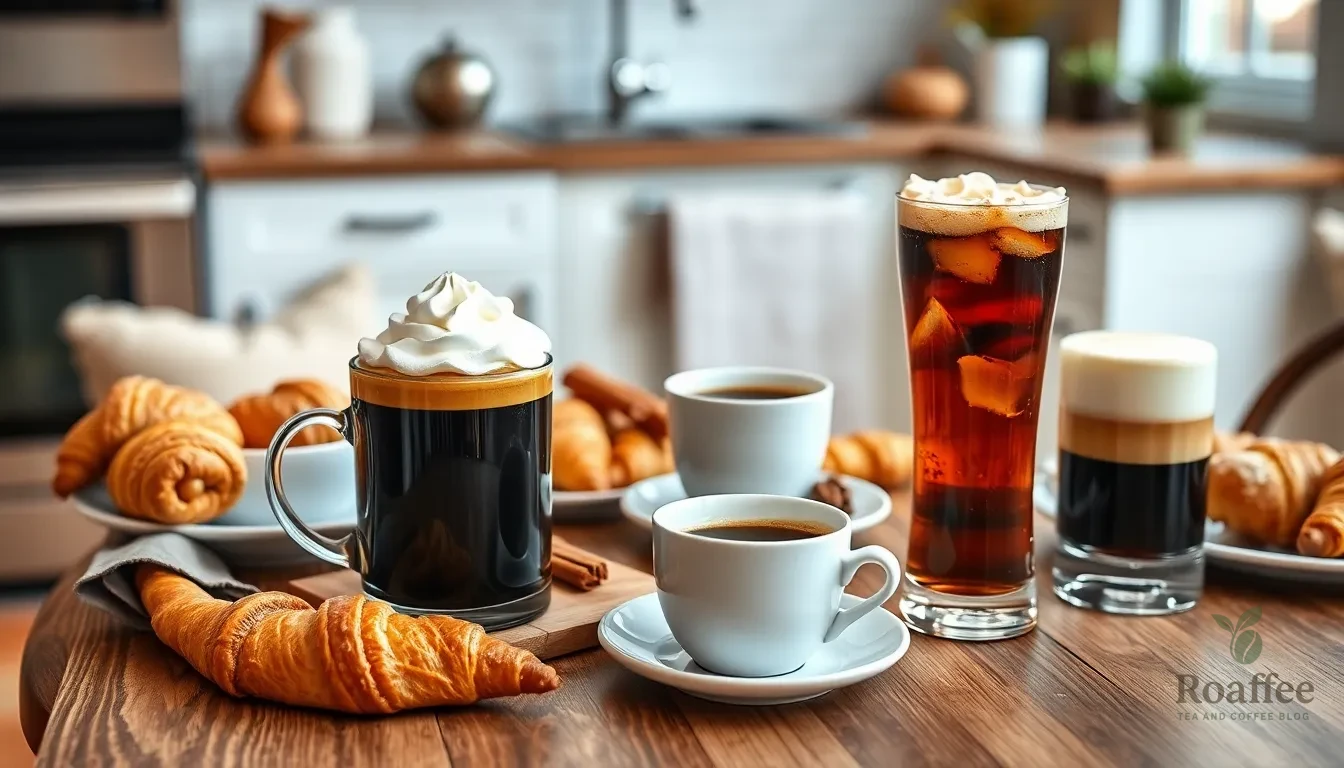
We elevate our homemade coffee experience by pairing our perfectly brewed cups with thoughtful serving suggestions that enhance both flavor and presentation. Each brewing method we’ve mastered deserves exact serving recommendations that maximize its unique characteristics.
Hot Coffee Presentations
Our pumpkin spice latte reaches its peak when served immediately in warmed mugs topped with homemade whipped cream and a light dusting of pumpkin spice. We recommend serving this seasonal favorite at temperatures between 145°F to 155°F for optimal warmth without scalding. The aromatic steam carries the spice blend perfectly when we present it in clear glass mugs that showcase the rich amber color.
Classic black coffee shines brightest when we serve it hot in preheated ceramic cups that retain heat longer. We offer milk and sweetener on the side to let each person customize their perfect balance. The pure coffee flavor develops best when we maintain serving temperatures around 140°F to 150°F.
Our cafe-style hot beaten coffee creates an impressive presentation when we pour the frothed milk base into tall glasses and gently layer the beaten coffee mixture on top. We finish with a sprinkle of cinnamon or cocoa powder for visual appeal and added flavor depth. The contrast between the creamy milk and dark coffee creates an Instagram-worthy presentation.
Cold Coffee Service
Cold brew coffee transforms into a sophisticated drink when we serve it over large ice cubes in tall glasses with a splash of cream swirled on top. We recommend offering simple syrup or cold milk on the side to accommodate different sweetness preferences. The smooth, less acidic profile pairs beautifully with a light breakfast or afternoon pastry.
Our cafe-style cold coffee becomes a dessert-like treat when we add vanilla ice cream scoops and serve it in chilled glasses with long spoons. We garnish with whipped cream and a drizzle of chocolate syrup for an indulgent presentation. This serving style works perfectly for warm weather entertaining or as an after-dinner treat.
Timing and Temperature Guidelines
| Coffee Type | Serving Temperature | Optimal Serving Window | Glassware |
|---|---|---|---|
| Hot Beaten Coffee | 145°F – 155°F | 5 minutes after brewing | Tall glasses |
| Pumpkin Spice Latte | 145°F – 155°F | Immediately | Warmed mugs |
| Classic Black Coffee | 140°F – 150°F | 3-5 minutes | Ceramic cups |
| Cold Brew | 35°F – 40°F | Up to 2 hours | Tall glasses |
| Cold Coffee | 32°F – 38°F | 10 minutes | Chilled glasses |
Enhancement Pairings
We amplify our coffee experience by selecting complementary foods that enhance rather than compete with our carefully crafted flavors. Light pastries like croissants or biscotti pair beautifully with our classic black coffee, while our pumpkin spice latte complements autumn treats like cinnamon rolls or apple turnovers.
Our cold brew coffee pairs exceptionally well with fresh fruit or light breakfast items that don’t overpower its subtle flavor notes. We serve our cafe-style cold coffee alongside simple cookies or shortbread that complement its creamy sweetness.
Professional Presentation Tips
We create cafe-quality presentation by warming our mugs and glasses before serving hot drinks and chilling our glassware for cold beverages. Small touches like placing coffee on saucers with a small spoon and napkin elevate the entire experience.
Our serving ritual includes offering our coffee within the optimal time windows specified in our guidelines above. We maintain the perfect temperature and texture that we worked so carefully to achieve during brewing.
Storage and Freshness Tips

Creating exceptional coffee at home extends beyond mastering brewing techniques. We must prioritize proper storage to maintain the peak flavor and aroma of our carefully selected beans.
Buy whole beans instead of pre-ground coffee to preserve maximum freshness. Grinding increases surface area and accelerates staleness, which diminishes the complex flavors we work so hard to extract. When we grind coffee fresh just before brewing, we maximize flavor and aroma retention.
Purchase smaller quantities that match our consumption rate, ideally about one week’s supply, to avoid coffee going stale. This strategy ensures we always brew with beans at their peak freshness rather than letting them deteriorate over time.
Store coffee in an airtight container made of ceramic, glass, or non-reactive metal to protect against moisture, heat, and light exposure. These elements rapidly degrade coffee quality and rob our beans of their distinctive characteristics. Metal containers with tight-fitting lids work exceptionally well for maintaining optimal storage conditions.
Avoid storing coffee in the refrigerator or near heat sources like ovens or sun-exposed walls, as these environments harm freshness. Temperature fluctuations and moisture exposure create conditions that compromise the oils and compounds responsible for coffee’s rich flavor profile.
High-quality prepackaged coffee often features one-way valves that allow gases to escape while keeping air out, helping maintain freshness. These specialized packages protect newly roasted beans from oxidation during the critical first few weeks after roasting.
| Storage Method | Freshness Duration | Container Type | Location |
|---|---|---|---|
| Whole beans | 2-4 weeks | Airtight ceramic/glass | Cool, dark pantry |
| Ground coffee | 1-2 weeks | Sealed metal container | Away from heat sources |
| Opened package | 7-10 days | Original with valve | Room temperature |
Following these storage practices allows us to enjoy the freshest coffee flavor and maintain the quality of our homemade café-style brew. Fresh coffee beans form the foundation of every exceptional cup, making proper storage an essential skill for any home coffee enthusiast.
Conclusion
Creating exceptional coffee at home isn’t just about following a recipe—it’s about understanding the fundamentals that make each cup extraordinary. With the right equipment precise measurements and proper technique we’ve shown you how to transform your daily coffee routine into something truly special.
The key lies in attention to detail: fresh beans proper storage optimal water temperature and consistent timing. These elements work together to unlock the full potential of your coffee beans whether you prefer pour-over French press espresso or cold brew.
Now that you’re equipped with these professional brewing secrets there’s no need to spend a fortune at coffee shops. Your kitchen can become your personal café where every cup meets your exact preferences. Start experimenting with these methods and discover which brewing style creates your perfect morning ritual.
Frequently Asked Questions
What equipment do I need to make barista-level coffee at home?
The essential equipment includes a burr grinder for even bean grinding, a digital scale for precise measurements, and your preferred brewing device (French press, pour-over dripper, AeroPress, or drip coffee maker). A gooseneck kettle helps control water temperature, and a timer ensures consistent brewing times. Optional tools like a water thermometer, airtight storage containers, and quality water filters can further enhance your brewing experience.
What’s the best coffee-to-water ratio for home brewing?
The ideal coffee-to-water ratio depends on your brewing method and taste preferences. Generally, a 1:15 to 1:17 ratio works well for most methods. For example, use 1 gram of coffee for every 15-17 grams of water. Pour-over typically uses 1:16, while French press may use 1:15 for a stronger brew. Always use a digital scale for accuracy.
What water temperature should I use for brewing coffee?
The optimal water temperature for brewing coffee is between 195°F to 205°F, with 198°F to 202°F being the sweet spot. This temperature range ensures proper extraction without over-extracting bitter compounds. Water that’s too hot will burn the coffee, while water that’s too cool will under-extract, resulting in weak, sour-tasting coffee.
How long should I brew coffee for each method?
Brewing times vary by method: pour-over takes 2.5-4 minutes, French press needs 4-5 minutes, espresso requires 25-30 seconds, and cold brew steeps for 12-24 hours. AeroPress typically takes 1-2 minutes. Following these time guidelines ensures optimal extraction and prevents over-brewing, which can lead to bitter flavors.
Should I buy whole beans or pre-ground coffee?
Always buy whole beans instead of pre-ground coffee. Whole beans retain their freshness, aroma, and flavor much longer than ground coffee. Coffee begins losing its quality within minutes of grinding due to oxidation. Grind your beans just before brewing for the best taste and aroma in your cup.
How should I store coffee beans to maintain freshness?
Store coffee beans in airtight containers made of ceramic, glass, or non-reactive metal. Keep them in a cool, dry place away from direct sunlight, heat sources, and moisture. Avoid storing coffee in the refrigerator or freezer. Buy smaller quantities to ensure you use beans within 2-4 weeks of roasting for optimal freshness.
What’s the difference between light, medium, and dark roast coffee?
Light roast coffee has bright, acidic flavors with floral and fruity notes. Medium roast offers balanced acidity and body with caramel sweetness. Dark roast features bold, smoky flavors with lower acidity and oils on the surface. Choose based on your flavor preferences: light for brightness, medium for balance, or dark for intensity.
Can I make cold brew coffee at home?
Yes, cold brew is easy to make at home. Use a coarse grind and a 1:4 coffee-to-water ratio. Steep the grounds in cold water for 12-24 hours, then strain. This method produces a smooth, low-acid concentrate that can be diluted with water or milk. Cold brew keeps in the refrigerator for up to two weeks.

